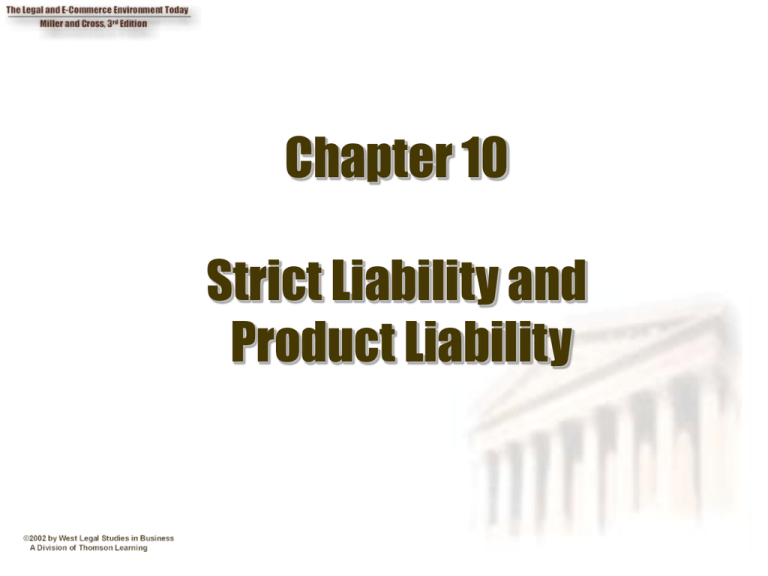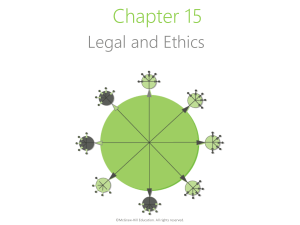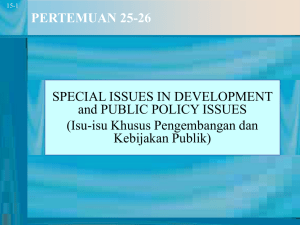Strict Liability and Product Liability
advertisement

Chapter 10 Strict Liability and Product Liability Chapter Objectives 1. Explain what is meant by strict liability. 2. Describe the types of warranties that may arise in a sales or lease transaction. 3. Discuss how negligence and misrepresentation can provide a basis for a product liability action. 4. List the requirements for an action in strict liability. 5. Summarize the defenses that can be raised against product liability claims. 2 Product Liability The legal liability of manufacturers, sellers, and lessors of goods to consumers, users, and bystanders for injuries or damages that are caused by the goods. Product liability claims are most often based on: Warranty Law Negligence Misrepresentation Strict Liability 3 Warranty Law Under the Uniform Commercial Code, certain warranties can arise in a contract for sale of goods. Consumers and others can recover from any seller for losses resulting from a breach of: Express warranties: those made by oral or written representations concerning the goods Implied warranties 4 Implied Warranties Warranty of Merchantability: A merchant warrants goods are “reasonably fit for the ordinary purposes for which such goods are used.” Applies only to merchants! Warranty of Fitness for a Particular Purpose: Arises when any seller knows of the particular purpose for which a buyer will use the goods and knows the buyer is relying on the seller to select suitable goods. 5 Negligence In order to prevent claims of negligence, due care must be used by the manufacturer in: Designing the product Selecting materials Using the appropriate production process Assembling and testing the product Placing adequate warnings on the label or product 6 Sometimes, “Puffery” Becomes the “Basis of the Bargain” Michael and Carla Weng bought a used car that the salesperson claimed was “in good condition,” was “a good reliable car,” was “mechanically sound,” and had “no problems.” The Wengs believed his words constituted an expressed warranty, so when the car gave them trouble, the Wengs sued the dealer for breach of warranty. At trial, the Wengs lost because the statements were mere puffery. However, on appeal they won because the statements were “part of the basis of the bargain.” In reading the court’s words, is there really a clear line between language considered to be mere puffing and language considered to create an express warranty? 7 Privity of Contract Privity of contract is not required. A manufacturer is liable for failure to exercise due care to any person who sustains an injury proximately caused by a negligently made (defective) product. 8 Misrepresentation Fraudulent misrepresentation of a product may result in product liability based on the tort of fraud. Examples include: Intentional mislabeling of packaged cosmetics Intentional concealment of a product’s defects 9 Strict Liability Under the doctrine of strict liability, people may be liable for the results of their acts regardless of their intentions or their exercise of reasonable care. If a child is injured by a toy, should the manufacturer be held liable regardless of the circumstances? 10 MacPherson v. Buick Motor Co. (1916) Donald MacPherson was thrown from a Buick automobile after one of its wheels collapsed. He suffered injuries and brought suit against Buick Motor Co. The court held that Buick had a duty to inspect the wheels, even though it didn’t manufacture them, and held them responsible for the injury. What doctrine (just discussed) did Buick try to argue in its defense? To what extent, if any, have technological developments contributed to the courts placing less emphasis on the doctrine of caveat emptor (“let the buyer beware”) and more emphasis on caveat venditor (“let the seller beware”)? 11 Requirements of Strict Product Liability—Summarized The defendant must sell the product in a defective condition. The defendant must normally be engaged in the business of selling that product. The product must be unreasonably dangerous to the user or consumer because of its defective condition (in most states). A court may consider a product so defective as to be unreasonably dangerous if either (a) the product was dangerous beyond the expectation of the ordinary consumer or (b) a less dangerous alternative was economically feasible for the manufacturer, but the manufacturer failed to produce it. The plaintiff must incur physical harm to self or property by use or consumption of the product. The defective condition must be the proximate cause of the injury or damage. The goods must not have been substantially changed from the time the product was sold to the time the injury was sustained. 12 Case 10.1 Greenman v. Yuba Power Products, Inc. When Greenman was injured by a defect in the design of a “Shopsmith” woodworking tool, he sued claiming breach of warranty and negligence. The court instead held the manufacturer strictly liable. What rationale did the court use to support its decision? What UCC rule did the manufacturer refer to when it argued that the plaintiff had “waited too long” to give notice of the breach of warranty? What ethical doctrine underlies this rule? 13 Section 402A of the Restatement (Second) of Torts 1. One who sells any product in a defective condition unreasonably dangerous to the user or consumer or to his property is subject to liability for physical harm thereby caused to the ultimate user or consumer or to his property, if a. the seller is engaged in the business of selling such a product, and b. it is expected to and does reach the user or consumer without substantial change in the condition in which it is sold. 14 Section 402A of the Restatement (Second) of Torts 2.The rule stated in Subsection (1) applies although a. the seller has exercised all possible care in the preparation and sale of his product, and b. the user or consumer has not bought the product from or entered into any contractual relation with the seller. 15 Market-Share Liability In cases in which plaintiffs cannot prove which of many distributors of a harmful product supplied the particular product that caused the plaintiffs’ injuries, some courts have applied market-share liability. All firms that manufactured and distributed the harmful product during the period in question are then held liable for the plaintiffs’ injuries in proportion to the firms’ respective shares of the market, as directed by the court. 16 Product Defect and Strict Liability Claims Claims that a product is so defective as to be unreasonably dangerous generally allege that the product is unreasonably dangerous for one of the following reasons: Because of a flaw in the manufacturing process Because of a design defect Because the manufacturer failed to warn adequately of harms associated with the product’s use 17 Case 10.2 Rogers v. Ingersoll-Rand Co. In the maintenace manual that accompanies the milling machine made by Ingersoll-Rand, there are warnings that users should stay 10 feet away from the rear of the machine when it is operating, verify the alarm is working, and check the area for the presence of others. Terrill Wilson, while operating the machine, ran over Cosandra Rogers when the back-up alarm did not sound. She was maimed and filed a suit against Ingersoll-Rand alleging design defect. She was awarded $10.2 million in compensatory damages and $6.5 million in punitive damages. What other safety features might a manufacturer use in these circumstances? 18 Inadequate Warnings At what point does the manufacturer’s responsibility for consumer safety end and the consumer’s responsibility for his or her own safety begin? Courts generally try to balance the policy of protecting consumers with the policy that manufacturers cannot be the absolute insurers of the safety of all products on the market. Should consumers be warned that hot coffee can cause severe burns? 19 Other Applications of Strict Liability Bystanders: Manufacturers and other sellers are liable for harms suffered by injured bystanders due to defective products. Suppliers of Components: Suppliers of component parts are strictly liable for defective parts which, when incorporated into a product, cause injuries to users. 20 Defenses to Product Liability There are several defenses that manufacturers, sellers, or lessors can raise to avoid liability for harms caused by their products. Assumption of Risk Product Misuse Comparative Negligence Commonly Known Dangers Other Defenses 21 Defenses to Product Liability Assumption of Risk The user or consumer knew of the risk of harm and voluntarily assumed it. Product Misuse The user or consumer misused the product in a way unforeseeable by the manufacturer. 22 Defenses to Product Liability Comparative Negligence Liability may be distributed between plaintiff and defendant under the doctrine of comparative negligence. Commonly Known Dangers If a defendant succeeds in convincing the court that a plaintiff’s injury resulted from a commonly known danger, such as the danger associated with using a sharp knife, the defendant will not be liable. 23 Case 10.3 Travelers Ins. Co. v. Federal Pacific Electric Co. After RCA employees switched a circuit breaker on without testing for short circuits (causing an explosive fire), RCA’s insurer brought suit alleging that FPC was negligent in failing to provide adequate warnings. The court held there was “no necessity to warn a customer already aware—through common knowledge or learning—of a specific hazard.” What might have been the result in this case if the training, experience, and expertise of the employees dispatched to check the circuit breakers had been with a different, out-of-date technology? 24 Other Defenses Lack of Required Elements A defendant can also defend against a products liability claim by showing that there is no basis for the plaintiff’s claim (that the plaintiff has not met the requirements for an action in negligence or strict liability). 25 For Review 1. How does the doctrine of strict liability differ from the tort doctrines discussed in Chapter 9? 2. What factors determine whether a seller’s or lessor’s statement constitutes an express warranty or merely “puffing”? 3. Discuss whether a manufacturer can be held liable to any person who suffers an injury proximately caused by the manufacturer’s negligently made product. 4. What are the elements of a cause of action in strict product liability? 5. What defenses to liability can be raised in a product liability lawsuit? 26






